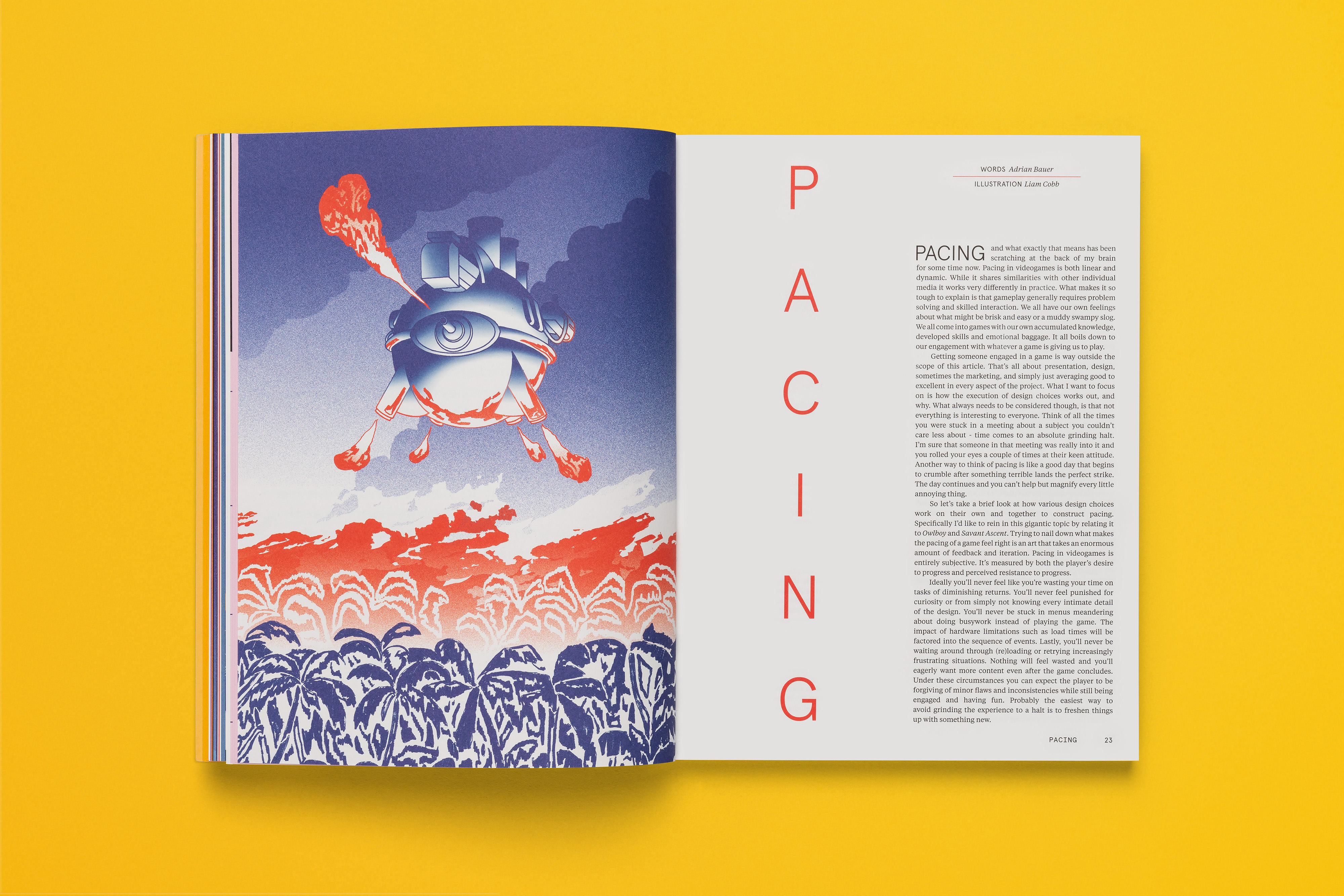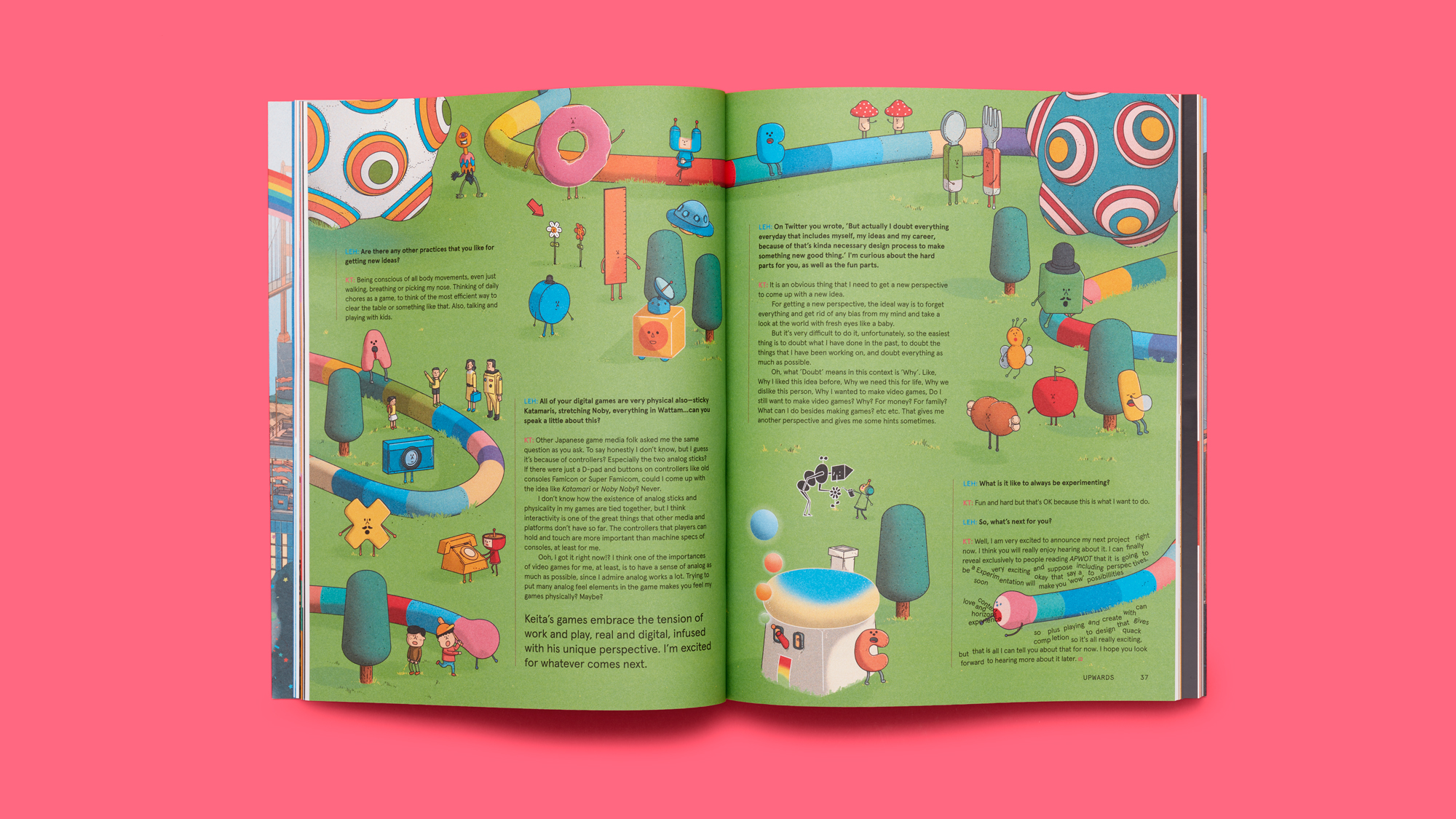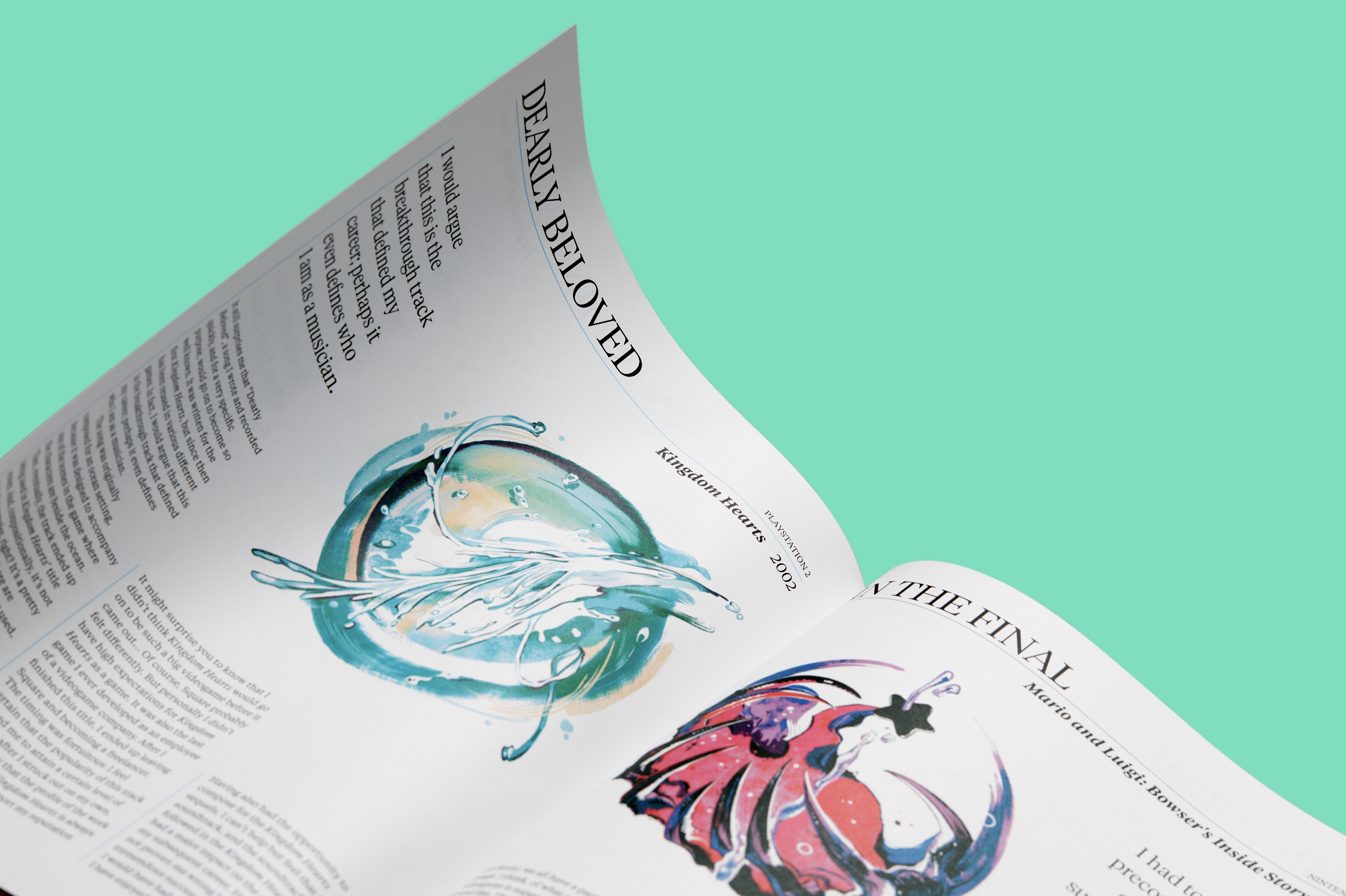All the way back in 2014, design student Caspian Whistler had an idea. Tired of the way games were being discussed in the mainstream, and with the market for video game magazines on the brink of collapse, he thought he'd try and make something that addressed both those issues.
So he started a zine, called A Profound Waste of Time, which would just...talk about video games and celebrate their visual appeal. No anger, no needless genre comparisons, no marketing. And instead of loads of screenshots, it would just look...nice?
These do not sound like incredible demands in 2023, but back then, they were not the kind of things people were being subjected to in a media landscape dominated by aggressive video game websites and a few remaining print magazines fighting for their lives.
That 2014 zine went on to become a magazine, one that was Kickstarted in 2016 and that looked so good I wrote about it on The Old Site despite it not even existing yet. When that was a success it led to a second issue. Then a third, which only last month landed in the mailboxes of fans around the world.
Now APWOT is about to begin work on a fourth issue, and at time of publishing, despite there being a whole week left on the Kickstarter, it has raked in over twice as much as it was asking for. That's a hit by any metrics, but for a video game magazine in 2023 it's remarkable, and is a real vindication of Whistler's original vision for the publication.
As a huge fan of APWOT, with my hands currently on issue three and with issue four on the way, I thought this was a great time to chat with Caspian about the inspirations behind the mag, how it all comes together and what he and his small team of helper's plans for the future are.
Disclaimer: Aftermath co-founder Gita Jackson is a featured contributor in APWOT's third issue.
Luke Plunkett: My first question would be...why? Why do this? Why did you decide to go and start a video game magazine in 2014, when the medium was supposedly on its deathbed?
Caspian Whistler: I was lucky enough to get to go to art school to study graphic design. While studying, I started paying attention to a lot of the high-end arts and culture periodicals that were out there. There was so much expansive and fantastically designed material on shelves for film, theatre or any other area of the arts and culture sector that you could think of. It struck me as really strange that there was nothing comparable for games, and the games magazines I’d read a lot of growing up were all such a far cry from this kind of production value. I wanted to give video games the same treatment, to package them in a way that helps communicate that they’re really important aspects of our modern culture.
The whole state of game discourse in 2014 felt really dire. So much of it felt exclusionary, and with an anger as the predominant prevailing emotion. With plenty of the videogame publications from my childhood closing down I thought perhaps I could do something disruptive and try and create my own take on it, something that rebelled against the whole direction games magazines were going in and was beautiful, expansive and welcoming. Something defiantly focused on being physical media and embracing what that means whole-heartedly.

I initially started making APWOT as a zine on my own, and just sort of used it as a soapbox to communicate about all these games I loved and draw some pretty pictures. The very first incarnation was only about 20 pages, and I did the art and writing in a short two week turnover. That initial project got featured on Destructoid’s community blogs in 2014. It made me feel like there might be an actual audience for this that would make it viable, so I tried to keep pursuing it after graduating in 2016. Graduating with an arts degree is scary at the best of times, so having something I was passionate about that other people seemed to care about too felt like the right thing for me to focus on.
LP: How did you ramp things up between that initial 2014 zine and the 2018 launch of the first proper issue? And then from there into the thing it is today?
CW: Issue one got over-funded by quite a bit and it was the first project I had done fresh out of uni. I think my own lack of experience paired with an increasing sense of pressure resulted in the mag growing way beyond what I originally scoped for. I felt I needed to deliver something really special, and the more things got delayed for one reason or another the greater that pressure became. The project bloated into a publication twice the page count and with much bigger page dimensions, and all of that makes it harder to get out quickly.

There wasn’t really a model for what APWOT was before this point, as there wasn’t a comparable magazine to my knowledge that was fully illustrated, that didn’t use screenshots, and was completely advert free. I had to work hard through a lot of trial and error to figure out how to make it a reality. By the time the magazine came out I needed a break, and I wanted to figure out what the next steps should be for me in my career.
I finally got round to doing issue two once I was getting more freelance work, but after the Kickstarter for that issue the pandemic hit, causing massive problems for production on every level. Once issue two came out, I had to make up a budget deficit as shipping costs had gone up so drastically that I couldn't afford to send the magazines out. Rather than asking backers to pay the difference I hurried to make a Kickstarter for a reprint of issues one and two which thankfully went really well.
Issue three is the first time that I’ve been able to just, you know, make the magazine with my current experience and in an unobstructed way. It also massively helps that I have enough budget now to bring in more people to help out the production process.
LP: So who is actually involved in putting the mag together, aside from yourself? Is it just you, or is it a team effort?
CW: So I’m the only person person working on the magazine full time, which is quite challenging. There isn’t really an official APWOT “team” that works on the mag, but there are two figures who have helped out a lot.
Godfathering the project as a producer and the person who gave me a lot of advice, especially in terms of how to get this thing off the ground, was Darren Wall. Darren is the founder of Volume and video game book publisher Read Only Memory. I’m lucky to have him helping and consulting on APWOT as a producer. I reached out to Darren when I first graduated, and he’s been helping ever since.
Since issue three we have author and journalist Simon Parkin working on the mag as an editor. It’s been amazing to have someone else’s involvement in terms of generating content for the mag, let alone someone who is as on top of their game and respected as Simon is. Commissioning and working with writers is a very fun experience, but it’s such a relief to have a true professional covering that side of things now.
So yeah while APWOT really isn’t a big operation by any means, the bit of regular help that I do get is from some people I have a lot of admiration and respect for, so I’m very blessed in that sense. I definitely want to bring more people who can help with production throughout the process, that’s a big aim going forward.

LP: What else do you do for a living outside of APWOT?
CW: I am a freelance graphic designer. I tend to do art direction for projects like music albums and other little oddities like that. Most of my bread-and-butter comes from working in film and animation studios on treatments and other stuff that they need designers for. I definitely want to get to the point where I can just pursue my own projects like APWOT, especially as an AI will probably be doing the bulk of my freelance work in a few years.
LP: What do you think APWOT brings to the space that other sites and magazines don't (or at least don't anymore)?
CW: When APWOT first launched (with the first Kickstarter in December 2016), I don’t think there was anything like it in terms of its approach to content and visuals. I really wanted to create a magazine that was the best showcase of design and writing, to try and create something that existed outside of the ecosystem of online websites, and that was very much tied to physical media. I think APWOT was really special in that way.
In the last few years there have been lots of new publications that have shown up in a similar vein, which I think proves that this format for games journalism and analysis resonates with people. In a sense, APWOT is a reaction to a lot of the same conditions that resulted in you guys creating Aftermath. That journalism and discussion around this medium can be engaging and interesting without the need to be anchored to the pay-per-click business model that has gripped so much of gaming culture within it’s vices over the last 20 years.
Thinking of APWOT today, the mag has frankly stupid production values. I say stupid because everything about it is made with the idea of “how can we make the best thing possible?” rather than what makes the most sense profit-wise. We print on premium art book paper stocks, mix multiple types and textures of paper together, have sections that unfold and much more. There are so many elements that come from APWOT really trying to justify it’s existence as a physical thing. I don’t think if you got a PDF of APWOT and read through it that it would be nearly the same experience, you’d miss out on so much of what makes it special. We also try to add special finishes and touches to covers, like glow-in-the-dark-ink, holofoil paper or ink that disappears when touched. I want APWOT to be an interactive experience, because that’s what games are.

Each issue is designed to be “timeless” in a sense. By that I mean that it will still be relevant and interesting 10 years down the line. APWOT deliberately doesn’t cover news or things that are incredibly “current”. News and reviews will always be better suited to online formats, therefore APWOT focuses on the broader topics around the medium. I think that people still enjoying issue one, which released back in 2018, is a testament to that.
The last element that I think makes APWOT special is the wild combination of contributors involved. Each line up for APWOT issues is stacked, and I don’t think you’ll find another place where names like Fumito Ueda, Rodney Greenblat, Yoko Shimomura, Bennett Foddy, Tim Schafer, Shu Takumi, Hiroyuki Sakamoto and more all together in one issue. I think that makes it truly special.
LP: Now that you're multiple issues into this, do you have any favourite pieces, either for their writing or illustration work (or both!)?
CW: Oh yeah, there are so many. I think in issue two it was a real highlight being able to work with Camille Young on the HAL history article. It was a commemorative retrospective for the celebration of HAL’s 40th anniversary, and we wanted to illustrate it by making 3D models in the style of the ones made for the promotional material for Earthbound / Mother.

Camille worked for months chipping away at this huge set of figurines. It would’ve been much easier to just render them in 3-D and simply emulate the physical nature of them digitally, but it just came out so fantastically having his actual physical model that we could photograph.

In issue three we also have this article that Simon suggested about WarioWare micro games, which initially felt too ambitious to do, but he really pushed for it and I’m so glad we went ahead with it. We basically got a bunch of our favourite creators from around the Industry to suggest micro game ideas to accompany a piece about WarioWare. Each microgame has its own little illustration and it was so fun to get to work with people like Toby Fox, Suda51, Ashly Burch, Ojiro Fumoto and more on this thing. The artist here is Indiana Jonas, who’s a talented illustrator and indie game developer:

I also have got to mention getting to work with Molly Mendoza on the illustrations for the Yoko Shimomura article. Shimomura spoke to APWOT about some of the iconic tracks from her career, and we worked with Molly to create some visual responses with a few word prompts and just her listening to the music. I think they came out really fantastically, and I love imaginative and innovative uses of illustration that relates to the text like that:

LP: What have you learned so far about making the mag that you've been able to put towards the production of issue four?
CW: Well, I’ve learnt how to make a magazine, which I straight up didn’t know much about when I started. Making a zine as a student and then managing prints of thousands and thousands of copies that all have to go out over the whole world was a very intense and steep learning curve. I really bit off more than I could chew at the start, but that might have been for the best in the end.
I think my whole mission throughout APWOT has been to try and create something that is deliberately slow but sustainable. That being said the main thing I’ve been trying to do for the last 12 months is to be able to get the magazine annualised, and we’ve managed to do that this time. My hope is that with APWOT coming out regularly that this will open up huge doors for the project going forward. I’d love to release things more regularly and dip my toe into other ideas and concepts that I want to pursue.
Making these issues is not an easy thing, it takes a huge amount of resources, time and energy, but I just love it and care about it so much that that’s okay for me. I hope to keep doing it as long as I can.
The fourth issue of A Profound Waste Of Time, due towards the end of next year, is now available to order on Kickstarter.


